Services on Demand
Journal
Article
Indicators
-
 Cited by SciELO
Cited by SciELO -
 Access statistics
Access statistics
Related links
-
 Cited by Google
Cited by Google -
 Similars in
SciELO
Similars in
SciELO -
 Similars in Google
Similars in Google
Share
Ingeniería y Universidad
Print version ISSN 0123-2126
Ing. Univ. vol.19 no.1 Bogotá Jan./June 2015
https://doi.org/10.11144/Javeriana.iyu19-1.mmcp
Mental Models Consensus Process Using Fuzzy Cognitive Maps and Computing with Words1
Proceso de consenso en modelos mentales usando mapas cognitivos difusos y computación con palabras2
Karina Pérez-Teruel3
Maikel Leyva-Vázquez4
Vivian Estrada-Sentí5
1Submitted on: February 13th, 2014. Accepted on: September 17th, 2014. This article is derived from the doctoral research Fuzzy Cognitive Maps Consensus Model for Group Decision Making, develop by the authors.
2Fecha de recepción: 13 de febrero de 2014. Fecha de aceptación: 17 de septiembre de 2014. Este artículo es el resultado de la investigación "Fuzzy Cognitive Maps Consensus Model for Group Decision Making" realizada por los autores del mismo.
3Software engineer, ISPJAE. Master in Bioinformatics, INSTEC. Professor at the University of Informatics Sciences (UCI). La Habana, Cuba. email: karinapt@uci.cu.
4Software engineer, ISPJAE. Master in Bioinformatics, INSTEC. PhD in Technical Sciences. Professor at the University of Informatics Sciences. La Habana, Cuba. email: mleyvaz@uci.cu.
5Mathematician, computer specialist. PHD in Technical Sciences. Professor at the University of Informatics Sciences (UCI). La Habana, Cuba. email: vivian@uci.cu.
Para citar este artículo / To cite this article
K. Pérez-Teruel, M. Leyva-Vázquez and V. Estrada-Sentí, "Mental models consensus process using fuzzy cognitive maps and computing with words", Ing. Univ., vol. 19, no. 1, pp. 173-188, Ene.-Jun., 2015. http://dx.doi.org/10.11144/Javeriana.iyu19-1.mmcp
Abstract
Fuzzy Cognitive Maps (FCM) has proven to be useful for representing both individual and collective mental models. Their capacity to be aggregated from individual FCM makes them suitable as a technique to assist in group decision making. For problems such as the analysis of complex systems and decision making usually is necessary a consensus process, to enable the group to achieve a state of mutual agreement among its members. In this paper a model for consensus processes in mental models using FCM and linguistic 2-tuple model as a form of causal knowledge representation is presented. The model includes automatic search mechanisms for conflict areas and recommendations to the experts to bring closer their preferences. An illustrative example that corroborates the applicability of the model is described.
Keywords: consensus; mental models; fuzzy cognitive maps; computing with words; Brooks' law
Resumen
Los mapas cognitivos difusos (MCD) han resultado útiles para la representación de modelos mentales individuales y colectivos. Su capacidad para ser agregados y construir MCD grupales a partir de MCD individuales, los hace apropiados como técnica en la toma de decisiones en grupo. Para problemas como el análisis de sistemas complejos y la toma de decisiones, usualmente se hace necesario un proceso de consenso que permita lograr en el grupo un estado de acuerdo mutuo entre sus miembros. En el presente trabajo se desarrolla un modelo para procesos de consenso en modelos mentales usando MCD como forma de representación del conocimiento causal y las 2-tuplas lingüísticas para representar la incertidumbre. El modelo incluye mecanismos automáticos de búsqueda de las áreas en conflicto y de recomendación a los expertos para acercar sus valoraciones. Se describe un ejemplo ilustrativo que permite corroborar la aplicabilidad de la propuesta.
Palabras clave: consenso; modelos mentales; mapas cognitivos difusos; computación con palabras, ley de Brooks
1. Introduction
The development and evolution of individual and collective mental models is important for continuous learning in intelligent organizations [1]. Mental models are used in multicriteria decision support, knowledge management [2], learning and assessment of complex systems knowledge among other areas [3].
Mental models are personal, internal representations of external reality that people use to interact with the world. Its development is based on personal experiences and perceptions. Mental models are dynamical cognitive structures useful for causal knowledge elicitation and analysis [4]. Beside these facts, humans have limitation for representing the world around them. Consequently, mental models are uncompleted representation of reality [5] making necessary the development of collective mental models.
Cognitive maps, proposed by [6], have been used as a visual representation of mental models [7]. Nodes represent concept or variables in a domain. Arcs indicate positive or negative causal connections. Cognitive mapping lacks representation of uncertainty in causal relation, an important factor in complex systems modeling [8].
Fuzzy cognitive maps (FCM) [9] extends cognitive maps with fuzzy values in (-1,1) or linguistic values to indicate the strength of causal relations, usually elicited from experts [10], [11]. FCM can be aggregated in collective causal models making this technique very attractive for group decision making and multi-experts modeling of complex systems [12], [13].
Group decision support and complex systems modeling makes recommendable to develop a consensus process [14]-[16]. Consensus is defined as a state of agreement among members of a group. A consensus reaching process is an iterative process comprising several rounds where the experts adapt their preferences [15].
Despite the fact that FCM application have been growing in different domains, specially in the last decade, there is still some limitations that affect further applicability of this technique [11]. One of them is the applicability to mental model modeling and analysis for decision support. Some of the main drawbacks in this area are the lack of consensus models and the interpretability by experts. Causal relations are frequently represented using numerical values instead of linguistic terms. This last option is more natural for eliciting and analyzing knowledge from experts [17].
There are some reported methods for generating consensus FCM, mainly for decision support [18]-[21]. The Delphi method [22] and a proposal from Bryson [14] are the main options. As measures of the consensus process quality, the reduction in the number or rounds and participants satisfaction have been identified. In this work we identify the following limitations in the consensus process applied to FCM:
- Lack of conflict areas identification of the causal relations that each expert should modify.
- Lack of automatic advice generation to help individual in causal knowledge variation in order to improve the agreement.
The aim of this work is to develop a new model of consensus reaching in mental models using FCM for representing causal knowledge and the linguistic 2-tuple model for representing causality strength, including areas of conflicts searching and automatic advice generation.
The outline of this paper is as follows: Materials and Methods section is dedicated to consensus process, fuzzy cognitive maps and 2-tuple linguistic representation model for computing with words (CWW). The new model for consensus in mental models elicitation using FCM is presented in Section 3. A case study is shown in section 4. The paper closes with concluding remarks and discussion of future work.
2. Materials and Methods
2.1. Consensus Process
Many group decision making activities involve individuals with different mental models. Through iteration and debate, members try to conciliate diverse positions. Cognitive consensus is defined as the similarity between members of a group about a key subjects in discussion [23].
Consensus is an active area of research in areas such as group decision making and learning [1], [24]. A consensus reaching process is defined as a dynamic and iterative process composed by several rounds where the experts express, discuss, and modify their opinions [15]. The process is generally supervised by a moderator (Figure 1), who helps the experts to make their point of view closer to each others.
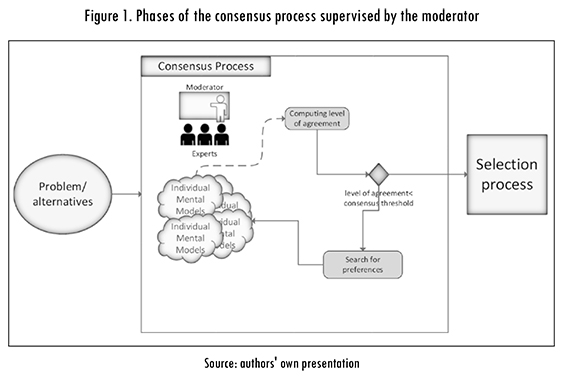
A frequent approach to consensus modeling involves the aggregation of preferences and the computing of individual differences with that value. In each round the moderator helps to make closer the opinions with discussions and advices to experts [14].
A consensus previous to group decision making allows the discussion and change of preferences helping to reach a state of agreement satisfying participants. Consensual points of view obtained from this process provide a stable base for decisions [24].
2.2. Fuzzy Cognitive Maps
A fuzzy cognitive map (FCM) [4] is a cognitive map that incorporates ideas from fuzzy logic. FCM are fuzzy graphs structures that represent causal knowledge [25].
The matrix representation of FCM allows to made causal inferences. In numerical FCM there are three possible types of causal relations between nodes represented in the matrix:
- Wij < 0, which indicates negative causality between nodes Ci and Cj The increase (decrease) in the value of Ci leads to the decrease (increase) in the value of Cj.
- Wij > 0, which indicates positive causality between nodes Ci and Cj. The increase (decrease) in the value of Ci leads to the increase (decrease) in the value of Cj.
- Wij = 0, which indicates no relationship between nodes Ci and Cj.
Due to their simplicity and usefulness, FCM have been applied to many diverse areas. Decision support and complex systems analysis are areas of active applications [26]. Moreover multiples extensions have been developed such as fuzzy grey cognitive maps [27], interval fuzzy cognitive maps [28], intuitionistic fuzzy cognitive maps [29] and linguistic 2-tuple fuzzy cognitive maps [30].
An important activity in group decision making is the development of collective models. FCM aggregation makes easy the development of collective causal models [31]. Despite the previous fact, the presence of human errors and outliers in causal relation affect the reliability of the aggregated models [12], [32]. The development of consensus reaching process previous to the aggregation is a way to reduce these limitations.
2.3.2-Tuple linguistic representation model for CWW
The linguistic representation model based in 2-tuples defines a set of transformation functions for linguistic 2-tuple in order to carry out the CWW process without loss of information [33]. This model has many advantages for dealing with linguistic information making easy the elicitation of preferences and knowledge from experts [34].
Definition 1. [35] Being β ∈[0, g] a value that represents the result of a symbolic operation in the interval of granularity of the linguistic terms set S = {S0, ..., Sg}. The symbolic translation is a numerical value assessed in (-0.5, 0.5) that supports the difference of information between a counting of information β assessed in the interval of granularity [0,g] of the term set S and the closest value in {0, ..., g} which indicates the index of the closest linguistic term in S.
The 2-tuple linguistic representation model defines a set of transformation functions between numeric values to facilitate linguistic computational processes.
Definition 2. [35] The 2-tuple that expresses the equivalent information to b is obtained with the function : Δ [0, g] → S X (-0.5, 0.5) given by.

where round is the usual rounding operation, si has the closest index label to si and α is the value of the symbolic translation.
We note that Δ function is bijective [35] and Δ-1 [0, g] → S X (-0.5, 0.5) is defined by:

Then the 2-tuples of S X (— 0.5, 0.5) will be identified with numerical values in the interval [0, g].
3. Consensus process in mental models
In this section a scheme of the proposed consensus model is presented (Figure 2). Its phases in conjunction with the mathematical model are described in detail below. This model is inspired in notions of consensus reaching under linguistic preferences [15], [36].
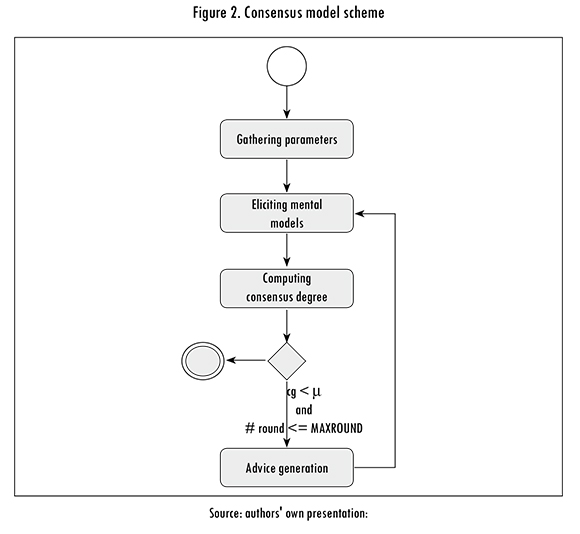
- Gathering parameters: The experts are selected, the granularity of the linguistic term set and the scope of the mental model are defined. Parameters are gathered for controlling the consensus process: consensus threshold µ ∈ [0,1] and MAXROUND ∈Ν to limit the maximum number of discussion rounds. Acceptability threshold ε > 0, to allow a margin of acceptability for prevents generating unnecessary recommendations is also gathered.
- Eliciting mental models: for each expert his/her mental model is gathered using the linguistic term set chosen for expressing causality. The weight from concept Ci to concept Cj given by expert k is represented my means of the 2-tuple linguistic model as follows:
- Computing consensus degree: The degree of collective agreement is computed in [0,1]. For each causal relation its corresponding β value (which will be denoted as βkij) is computed as follows:
- Consensus Control: Consensus degree cg is compared with the consensus threshold (µ). If cg > µ, the consensus process ends; otherwise, the process requires additional discussion. The number of rounds is compared with parameter MAXROUND to limit the maximum number of discussion rounds.
- Advice generation: When cg < µ, experts must modify the causal relations to make their mental model closer to each other and increase the consensus degree in the following round. Advice generation begin computing a collective FCM Wc = (wijc)nXn, wijc ∈ S x (-0.5,0.5). This collective mental model is computed aggregating each experts' mental model:


being Δ-1 the transformation function shown in (2).
For each pair of experts ek., et, (k < t), a similarity matrix SMkt (smktij)nXn, smktij ∈[0,1], is computed:

A consensus matrix CM = (cmij)nXn is obtained by aggregating similarity values:

where OAG1 is an aggregation operator, SIMij = {smij12,..., smijlm ,..., smij(m-1)m} represents all pairs of experts' similarities in their opinion on causal relation between (Ci, Cj) and cm is the degree of consensus achieved by the group in their opinion on causal relation between (Ci, Cj). Consensus degrees cni on each concept Ci, are computed as:


where µ ∈S and OAG2 is a 2-tuple aggregation operator.
After that, a proximity matrix (PPk) between each one of the ek experts and Wc is obtained. Proximity values, ppkij ∈ [0,1] are computed as follows:

Afterwards, causal relations to change (CC) are identified. Causal relation between concepts Ci and Cj with consensus degree under the defined (µ) are identified:

Later, based on CC, those experts who should change causal relations are identified. To compute an average proximity ppAij, proximity measures are aggregate.

where OAG2 is a 2-tuple aggregation operator.
Experts ek whose ppkij < ppAij are advised to modify their causal relation Wkij. Finally, direction rules are checked to suggest the direction of changes proposed. Threshold ε > 0 is established to prevent generating an excessive number of unnecessary advice.
DR 1: If βkij - βcij < -ε then ek should increase his/her the value of causal relation Wij.
DR 2: If βkij - βcij > ε then ek should decrease his/her the value of causal relation Wij.
DR 3: If -ε < βkij - βijC < ε then ek should not modify his/her the value of causal relation Wij.
4. Results
A case study is presented based on the Brooks' law that states ".. .adding manpower to a late software project makes it later..." [37]. The mental model used in this case is intended to provide solutions when adding people to a software project is ineffective.
In this case study three experts E={e1,e ,e3}(n = 3) are inquired about their mental model. A linguistic term sets with cardinality 9 is used to provide causal relations (Table 1).
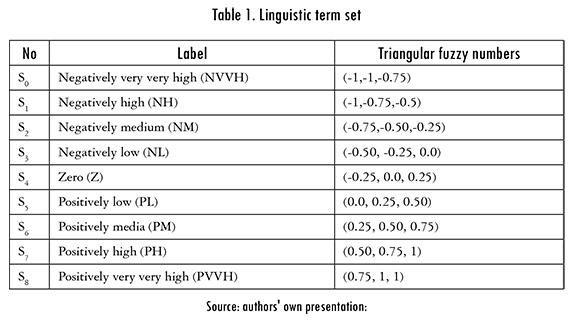
The scope of the mental model is defined by five concepts C = (C1,..., C5) shown in Table 2.
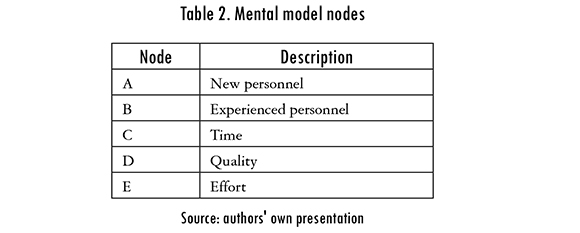
Parameters used in this case study are shown in Table 3. We apply the linguistic 2-tuple average operator [35] across this case study.

Initially, the experts provide the following linguistic causal relations.
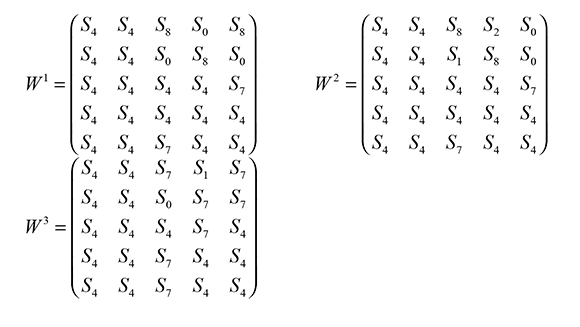
First round
The consensus matrix CM is obtained by aggregating similarity values (6) and is computed according to (8).

Consensus degrees cni on each concept are computed: (cn1 = 0.77, cn2 = 0.81, cn3 = 0.88, cn4 = 0.94 cn5 = 0.88) and consensus degree cg = 0.85. Because cg = 0.85 < µ = 0.9 the advice generation is activated. After that causal relation to change (CC) are identified (11).

Average proximity for this value (12) is computed as follows:

Proximity values for each expert in causal relations {w14, w , w25, w34, w35, w43, w53, w54} is as follows:
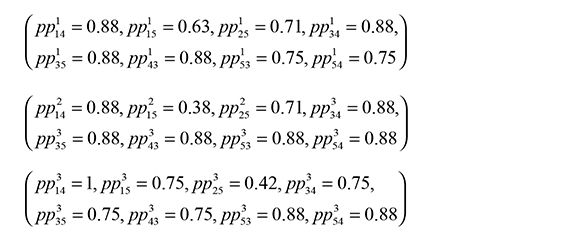
The sets of preferences to change (ppkij < ppAij ) are:

According to rule DR1, the experts are required to increase the following relations:

According to rule DR2, the experts are required to decrease the following relations:

And according to rule DR3 this relations should not be changed:

Second Round
According to the previous advices, the experts implemented changes, and the new elicited mental model are:
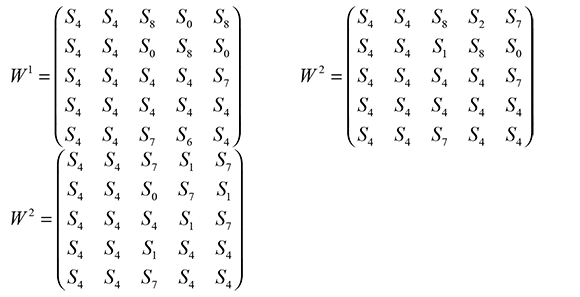
Because cg = 0.93 > µ = 0.9 the desired level of consensus is achieved.
The case study showed the applicability of the consensus model proposed. The experts found that FCM offers great flexibility for representing mental models. The interpretability of the 2-tuple linguistic representation model is another strength perceived. Additionally, the resulting collective mental model can be useful for future decision support and knowledge management in software engineering.
5. Conclusions
FCM are a useful representation of individual and collective mental models. Additionally their uses as decision support tool have proved to be useful. Despite this facts consensus process for group decision making based on FCM have received relatively little attention and the proposals lack some basic components.
In this paper a new model for consensus reaching using FCM and mental model representation is proposed. The linguistic 2-tuples representation model is used for representing causal relations and to develop CWW process. The proposal includes advice generation for identifying causal relation to change and suggest the direction of changes.
A case study applied to the modeling of the Brooks' law showed the applicability of the proposal. As future research we intend to develop a software tool and the use of multiple linguistic scales.
References
[1] P. Senge, La quinta disciplina en la práctica [Fifth discipline in the practice]. Barcelona: Ediciones Granica, 2005. [ Links ]
[2] G. Montibeller and V. Belton, "Causal maps and the evaluation of decision options-a review",J Operat Res Soc, vol. 57, no. 7, pp. 779-791, 2006. [ Links ]
[3] J. Ross, "Assessing understanding of complex causal networks using an interactive game", Dissertation. Information and Computer Science, University of California Irvine. [ Links ]
[4] N. A. Jones et al., "Mental models: an interdisciplinary synthesis of theory and methods", EcolSoc., vol. 16, no. 1, p. 46, 2011. [ Links ]
[5] P. M. Senge, La quinta disciplina: el arte y la práctica de la organización abierta al aprendizaje. Barcelona: Ediciones Granica, 2004. [ Links ]
[6] R. M. Axelrod, Structure of decision: The cognitive maps of political elites. Princeton NJ: Princeton University Press, 1976. [ Links ]
[7] S. IP Borgatti et al., "Network measures of social capital", Connections, vol. 21, no. 2, pp. 27-36, 1998. [ Links ]
[8] C. Puente Águeda et al., "Estudio de las relaciones causales", An mec electr. vol. 87, pp. 54-59, 2010. [ Links ]
[9] B. Kosko, "Fuzzy cognitive maps", Int J Man-Machine Studies, vol. 24, no. 1, pp. 65-75, 1986. [ Links ]
[10] C. W. Ping, A methodology for constructing causal knowledge model from fuzzy cognitive map to bayesian belief network. Bukgu, Gwangju, Corea del Sur: Chonnam National University, 2009. [ Links ]
[11] E. I. Papageorgiou and J. L. Salmeron, "A review of fuzzy cognitive maps research during the last decade", IEEE Transactions on Fuzzy Systems, 2012. [ Links ]
[12] M. Stajdohar and J. Demsar, "Interactive network exploration with orange", J Statist Software, vol. 53, no. 6, pp. 1-24, 2013. [ Links ]
[13] S. Gray, E. Zanre, and S. R. J. Gray, "Fuzzy cognitive maps as representations of mental models and group beliefs", en Fuzzy Cognitive Maps for Applied Sciences and Engineering. Berlín Heidelberg: Springer, 2014, pp. 29-48. [ Links ]
[14] N. Bryson, "Generating consensus fuzzy cognitive maps", en 1997 IASTED International Conference on Intelligent Information Systems (IIS '97), Grand Bahama Island, 1997. [ Links ]
[15] F. Mata, L. Martínez, and E. Herrera-Viedma, "An adaptive consensus support model for group decision-making problems in a multigranular fuzzy linguistic context", Fuzzy Systems, IEEE Transactions, vol. 17, no. 2, pp. 279-290, 2009. [ Links ]
[16] E. Herrera-Viedma et al., "Applying Linguistic OWA operators in consensus models under unbalanced linguistic information", en Recent developments in the ordered weighted averaging operators: theory and practice, Berlin Heidelberg: Springer, 2011. pp. 167-186. [ Links ]
[17] M. Espinilla et al., "An extended hierarchical linguistic model for decision[]making problems", Comput Intell., vol. 27, no. 3, pp. 489-512, 2011. [ Links ]
[18] S. Bueno and J. L. Salmeron, "Benchmarking main activation functions in fuzzy cognitive maps", Expert Syst Appl., vol. 36, no. 3, pp. 5221-5229, 2009. [ Links ]
[19] J. L. Salmeron, "Augmented fuzzy cognitive maps for modelling LMS critical success factors", Knowledge-Based Syst. vol. 22, no. 4, pp. 275-278, 2009. [ Links ]
[20] J. L. Salmeron, "Supporting decision makers with fuzzy cognitive maps", Res Technol Manag., vol. 52, no. 3, pp. 53-59, 2009. [ Links ]
[21] J. L. Salmeron et al., "Ranking fuzzy cognitive map based scenarios with TOPSIS", Expert Syst Appl., vol. 39, no. 3, pp. 2443-2450, 2012. [ Links ]
[22] H. A. Linstone and M. Turoff, The Delphi Method: tecniques and applications. Massachusetts: Addison-Wesley, 1979. [ Links ]
[23] M. Bunge, Causality and modern sciences. Nueva York: Dover, 1979. [ Links ]
[24] F. Mata, "Modelos para sistemas de apoyo al consenso en problemas de toma de decisión en grupo definidos en contextos lingüisticos multigranulares", tesis doctoral, Universidad de Jaén. Escuela Politécnica Superior de Jaén, Departamento de informática, Jaén, España, 2006. [ Links ]
[25] M. Leyva-Vázquez et al., "Técnicas para la representación del conocimiento causal. Un estudio de caso en Informática Médica", ACIMED, vol. 24, no. 1, pp. 73-83, 2013. [ Links ]
[26] M. Leyva Vázquez et al., "Modelo para el análisis de escenarios basados en mapas cognitivos difusos: estudio de caso en software biomédico", Ing Univ., vol. 17, no. 2, pp. 375-390, 2013. [ Links ]
[27] J. L. Salmeron, "Modelling grey uncertainty with fuzzy grey cognitive maps", Expert Syst Appl., vol. 37, no. 12, pp. 7581-7588, 2010. [ Links ]
[28] E. Papageorgiou et al., "Introducing Interval Analysis in Fuzzy Cognitive Map Framework" en: ABerlin Heidelberg: Springer, 2006. pp. 571-575. [ Links ]
[29] D. K. Iakovidis and E. Papageorgiou, "Intuitionistic fuzzy cognitive maps for medical decision making", Inf Technol Biomed, IEEE Transactions on, vol. 15, no. 1, pp. 100-107, 2011. [ Links ]
[30] K. P. Teruel, M. Leyva Vázquez y M. Espinilla Estévez, "Computación con palabras en la toma decisiones mediante mapas cognitivos difusos", RCCI, vol. 8, no. 2, pp. 19-34, 2014. [ Links ]
[31] M. S. Khan and M. Quaddus, "Group decision support using fuzzy cognitive maps for causal reasoning", Group Decis Negot., vol. 13, no. 5, pp. 463-480, 2004. [ Links ]
[32] W Stach, "Learning and aggregation of fuzzy cognitive maps-An evolutionary approach" ERA, tesis doctoral, Department of Electrical and Computer Engineering, University of Alberta, 2011. [ Links ]
[33] F. Herrera et al., "Computing with words in decision making: foundations, trends and prospects", Fuzzy Optimiz Decision Making, vol. 8, no. 4, pp. 337-364, 2009. [ Links ]
[34] K. Pérez-Teruel et al., "A linguistic software requirement prioritization model with heterogeneous information. 4th International Workshop on Knowledge Discovery, Knowledge Management and Decision Support (EUREKA 2013)", en Mazatlán, México, 2013. [ Links ]
[35] F. Herrera and L. Martínez, "A 2-tuple fuzzy linguistic representation model for computing with words", Fuzzy Systems, IEEE Transactions, vol. 8, no. 6, pp. 746-752, 2000. [ Links ]
[36] M. E. Newman, "Coauthorship networks and patterns of scientific collaboration", Proceed Nat Acad Sci., vol. 101(suppl 1), pp. 5200-5205, 2004. [ Links ]
[37] F. P. Brooks Jr, The mythical man-month, anniversary edition: essays on software engineering. Boston: Addison Wesley, 1995. [ Links ]













